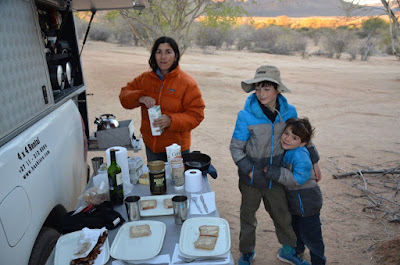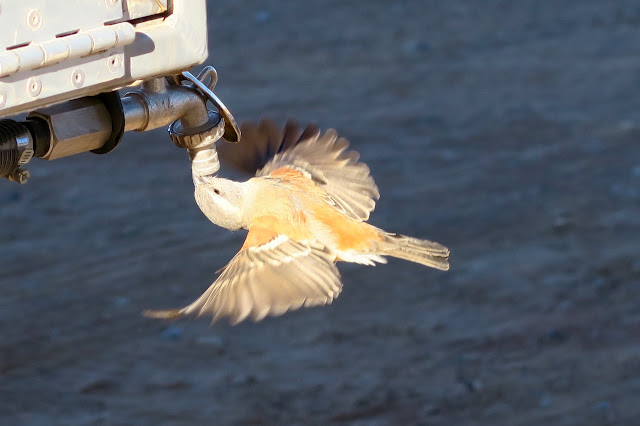So, careful what you wish for...this might be a bit dull for some.
The nitty-gritty often is.
|
 |
| Here's Eric wearing his seasick bands and diapers drying in the breeze behind him. |
Sailing the new boat to Australia felt like an amazing dream..to be able to sail the Pacific milk run twice in one lifetime! Too good to be true, really. And we were glad to have the knowledge we'd gained from our first crossing.
Then once we started sailing our new boat, we were thrown a curve ball. It was pretty clear that Eric was prone to serious mal de mar. He was 11 months old and we were coastal sailing from San Franscisco to San Diego. Any time the wind was forward of the beam - regardless of wind strength - it was time for Eric to vomit. Even with Eric's massive size for his age, he was still too small to medicate. I expressed concern to every pharmacist along the coast. We tried special acupuncture wrist bands that were sized for Eric, we tried lavender drops behind the ears, we tried ginger tea with honey (at room temperature). Nothing worked. And so, we departed CA with liters of oral rehydration drink from the pharmacy and a detailed chart about the signs of dehydration in babies and what to expect in terms of number of wet diapers per 3-4 hours. We felt that Eric would get his sea legs after a day or two. We also decided that instead of sailing the rhumb line to the Marqueses, we would sail a bit closer to the coast of Baja in case I had to fly with him from Cabo. So we had our backup plan in place.
As I said in the last post, the first 3 days of that passage were hard. Eric threw up a lot. Thankfully I was able to breast feed him while he was sleeping. This is after he vomited the first round of milk and fell asleep. Regular nursing while he slept was enough to keep him wetting his diaper every 3 hours or so.
 |
After vomiting, no food for at least an hour. About 20 min after vomiting we give 1 teaspoon of water every 5 minutes. So set your timers and do this for about an hour. You must push the fluids, small amounts at a time, even if the child is asleep - they must be roused enough to drink. Once things have mellowed out, a small sip from the kiddy water bottle replaces the 5mL tsp and is easier to drink while laying down. After 1-2 hours of this routine the child will hopefully need to pee.
If there are multiple episodes of throwing up, you may need to use proper rehydration formula instead of water. You can make oral rehydration by mixing 1/2 tsp salt, 6 tsp sugar and one L water. We carry Zofran as a treatment for multiple episodes of vomiting due to sea sickness. We have not needed it for the last two years, but it works great. If we need to use Zofran, we just give it 10 min after vomiting and then wait another 20 min to begin the rehydration steps listed above.
If there are multiple episodes of throwing up, you may need to use proper rehydration formula instead of water. You can make oral rehydration by mixing 1/2 tsp salt, 6 tsp sugar and one L water. We carry Zofran as a treatment for multiple episodes of vomiting due to sea sickness. We have not needed it for the last two years, but it works great. If we need to use Zofran, we just give it 10 min after vomiting and then wait another 20 min to begin the rehydration steps listed above.
I won't bore you with a list of all the medications that did not work. But I will say that we really tried them all - at least all ones that are suitable for children age-2 and older. Our golden day was when Eric was little older than 2 and an Australian chemist in Bundaberg suggested Phenergan (Promethazine hydrochloride 5mg/5mL). It is sold over the counter in Oz, but you need a prescription in the States. It has been our stand-by every since. Now, it is not a perfect treatment. There is the rare occasion where Eric will throw up anyway. But we just rehydrate him and then give him another dose of Phenergan later that day. Dosage is on the bottle. I give Eric one dose the night before, 3 doses per day for the first 2-3 days depending on weather conditions, then 1 dose each morning thereafter. If we encounter rough weather mid-passage then I may increase to 3 doses a day as per the bottle instructions. Eric always rests for about 20 min after taking Phenergan, then I get him up to begin his day.
And yes, I let him eat breakfast....but only if he eats it in the cockpit!
 |
| Eric (age 2) enjoying food while crossing the Tasman Sea. Happy boy! |







































